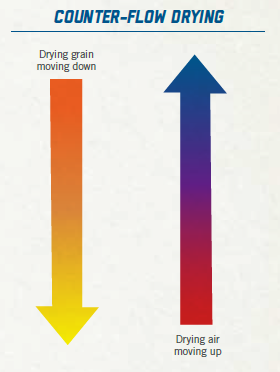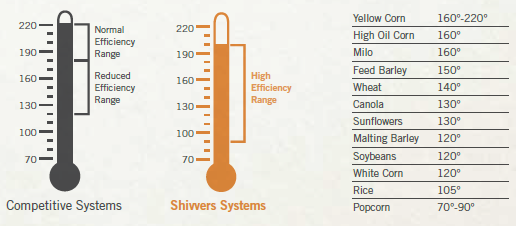The Counter-Flow Drying Process
 Each Shivvers System operates using the Counter-Flow Grain Drying Process - heated drying air flows upwards, counter to grain that is being drawn downward. What does this mean for you?
Each Shivvers System operates using the Counter-Flow Grain Drying Process - heated drying air flows upwards, counter to grain that is being drawn downward. What does this mean for you?
- Lower Operating Costs
- Uniform Drying
- Grain Quality Preservation
- Higher Test Weights
How It Works
Shivvers Systems operate by transforming your entire grain bin into a continuous-flow grain dryer. In the Counter-Flow drying process, air is concentrated and heated under the grain bin floor. Heated drying air is then forced up through the perforated drying floor and into the drying zone, ranging from 3-8 feet deep. The heated air continues to move upward through the grain - counter to the grain flow which is moving downward. While the majority of drying occurs in the primary drying zone (just above the bin floor), heated air that has not reached its maximum saturation capacity will continue to pull moisture from grain above the primary drying zone, as the air rises upward. Put simply, with Counter-Flow Drying, heated air is not wasted after it passes through the drying zone. Fully saturated air is then exhausted out the top of the bin.
| | While heated drying air is moving upward, wet grain is drawn downward. As grain reaches the pre-set transfer moisture level, sensors initiate Shivvers tapered sweep augers. Sweep augers begin rotating around the floor of the drying bin, removing an even layer of dry grain and allowing new layers of wet grain to enter the primary drying zone. Dry grain can then be either recirculated within the drying bin, or transported to external bins for storage. |
Maximum Efficiency, Uniform Drying, Higher Test Weights
| Because wet grain is exposed to heated air prior to entering the primary drying zone, the Counter-Flow process requires lower temperatures and less fuel than other systems. In fact, with its deeper drying zone, the Shivvers Performance System offers a more uniform drying process. This longer Retention Time - the amount of time grain spends exposed to drying air - the Counter-Flow drying process also preserves grain quality. | 
|
Other drying methods work by flash heating a small amount of grain at one time. This results in increased stress fractures, damaging qualities & lower test weights. The Counter-Flow drying process applies drying air to a larger area of grain with an increased retention time, preserving grain quality without sacrificing capacity.